Product research does not just happen in the initial stages of product development. Well-seasoned product managers know that the process is continuous. Businesses that perform best conduct regular product research to stay ahead of customer needs, market trends, and the competition.
This guide will help you to:
✅ Understand what product research is
✅ Learn if your product team should invest time and resources in it (and why)
✅ Get to know different product research methods, and when best to use them
✅ Plan your product research step by step
✅ Master product research with some best real-life tips
Without proper product research, your chances of success, like your product decisions, will be random. Learn from the market and your customers to make data-driven and customer-centric decisions.
We’ll show you how 🙌

What is product research?
Product research is a process in which you gather, analyze, and interpret data to make strategic decisions about a product's or feature’s development, improvement, or market positioning. It is a crucial part of the design and development process, whether for a new product or adding features to an existing one.
Product research helps evaluate market demand, analyze conditions and competition, and identify your target audience's needs, expectations, and pain points. The goal is to create products that meet user needs, reduce risks, and enhance user satisfaction.
Product research is essential before and after a product launch to ensure continuous improvement and alignment with market trends and customer preferences.
Types of product research
Product research has different facets depending on which stage of development you are, and what kind of insights you need. They all have a lot in common, but the focus angle will be different. 🔦
🔬Market research focuses on evaluating the market size, trends, competitive landscape, and customer demographics (within one market). It will help you assess whether your product has a chance to succeed on the intended market, identify opportunities, and optimize your overall product and marketing strategies.
🔬Customer research aims to understand customers' needs, preferences, behaviors, and experiences. Only then can you create products that meet their expectations and solve their problems.
🔬User research studies how users interact with a product to make sure it is user-friendly and meets real user needs. Its main focus is to gather insights on user behaviors, needs, motivations, and pain points to improve user experience and product usability.
🔬With product discovery, you want to identify and validate ideas for new products and features before development begins. The primary purpose is to minimize risks by validating assumptions and ensuring alignment with user needs and business goals.
🔬Continuous product discovery framework integrates into the daily workflow of product teams. Its main focus is to continuously gather insights from users to validate product assumptions, to ultimately build features that bring value for users but also align with business goals.
🔬Pricing research helps determine the optimal price for your product or service. It involves analyzing market demand, competition, and customer willingness to pay. The goal is to find a price threshold that maximizes revenue and meets market expectations at the same time.
Why do product teams need product research?
To some degree, all product teams need to have a well-established product research process.
Depending on the scope (is it a completely new product, or are you developing new features?) and stage of development (are you assessing your chances in the market or already prototyping?), teams will perform different research activities.
It’s never one size fits all, but it’s also an indisputable part of developing digital products.
To make informed decisions
The fundamental reason to do product research is to reduce the risks of failure.
And even though you might have heard it countless times, you cannot overrate the power of data-driven decisions. Product research provides concrete data, forming a foundation for making them, from feature prioritization to design choices.
To identify the problem and validate product ideas
Product research will help you uncover what your customers need and desire, as well as the challenges they face.
With a well-defined problem, it’s also easier to test and validate product ideas before you invest significant resources. This again reduces the risk of creating a product that misses the mark.
To gain a competitive edge
One integral element of product research is understanding your competition's offerings. Analyzing competitor products will help you identify opportunities for differentiation, making sure your product stands out in the crowded market.
Continuous market research will help you stay abreast of trends and evolving customer needs, ensuring that your product remains relevant.
Bonus: Customer-centric approach focused on user-centered design will also help you build a positive brand reputation.
To optimize product development
This one works two ways. First, by conducting thorough product research, you identify areas that need to be prioritized. It enables your teams to focus on aspects that resonate the most with users.
Second, you save money. Product research gives you tangible arguments for allocating resources better, thus preventing costly development mistakes.
For continuous improvement
As the development of digital products never ends but continues through iterations, you need a trend baseline to make sure that your product evolves in the right direction.
Bonus: Engaging directly with users during research helps develop empathy and improve retention, both of which are crucial for user-centric product development.
Product research methods
With the countless number of available product research methods, the most important part is choosing the right ones. Depending on when in the product development process you’d like to use them, the overall research goal, and the resources available, you might be using different combinations of primary and secondary research.
Surveys
Product surveys are a great way to learn how existing and potential customers feel about your product.
These surveys can include questions about what consumers think of your product, such as:
- What frustrates them the most
- What the most needed improvements include
- What their favorite features are, and more.
You can also gain insights into how these aspects compare to your competitors’ products.
Product surveys can be sent via email or link, in-app, in-product, or displayed on your website. This is probably the most convenient, affordable, and effort-efficient way of gathering information to fuel your product research.
Another kind of survey that can prove useful is a quarterly NPS (Net Promoter Score) survey. The open follow-up question can be a great source of new product and feature ideas.
In-app feedback
In-app feedback and in-product surveys are perfect for gathering real-time user feedback and addressing user issues promptly. They provide immediate user insights that add to your continuous improvement efforts.
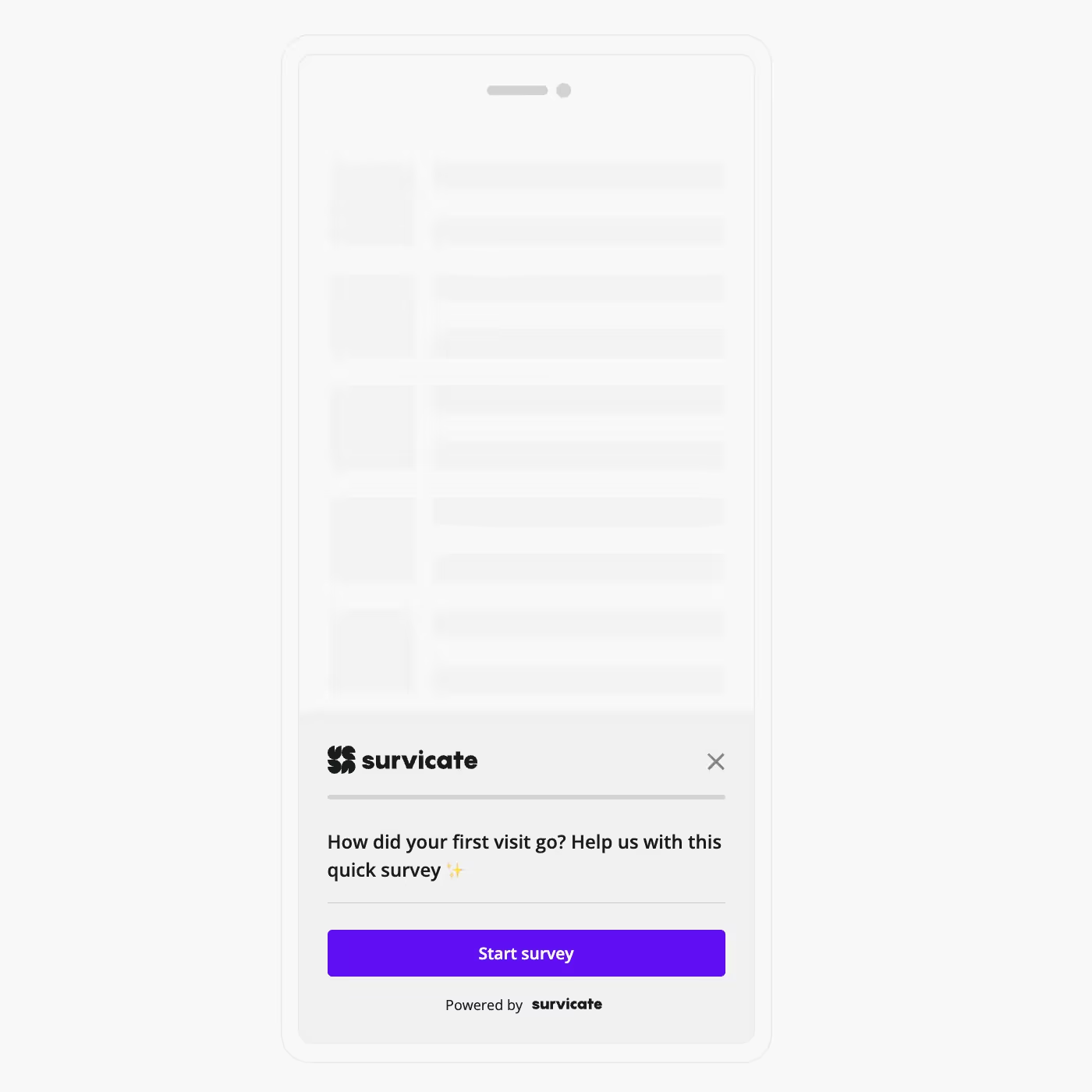
With in-product surveys, you can easily stay on top of contextual feedback on existing or new features and recent updates.
Customer reviews
Customer reviews provide unprompted feedback provided by users on various platforms, such as e-commerce sites, social media, and review websites.
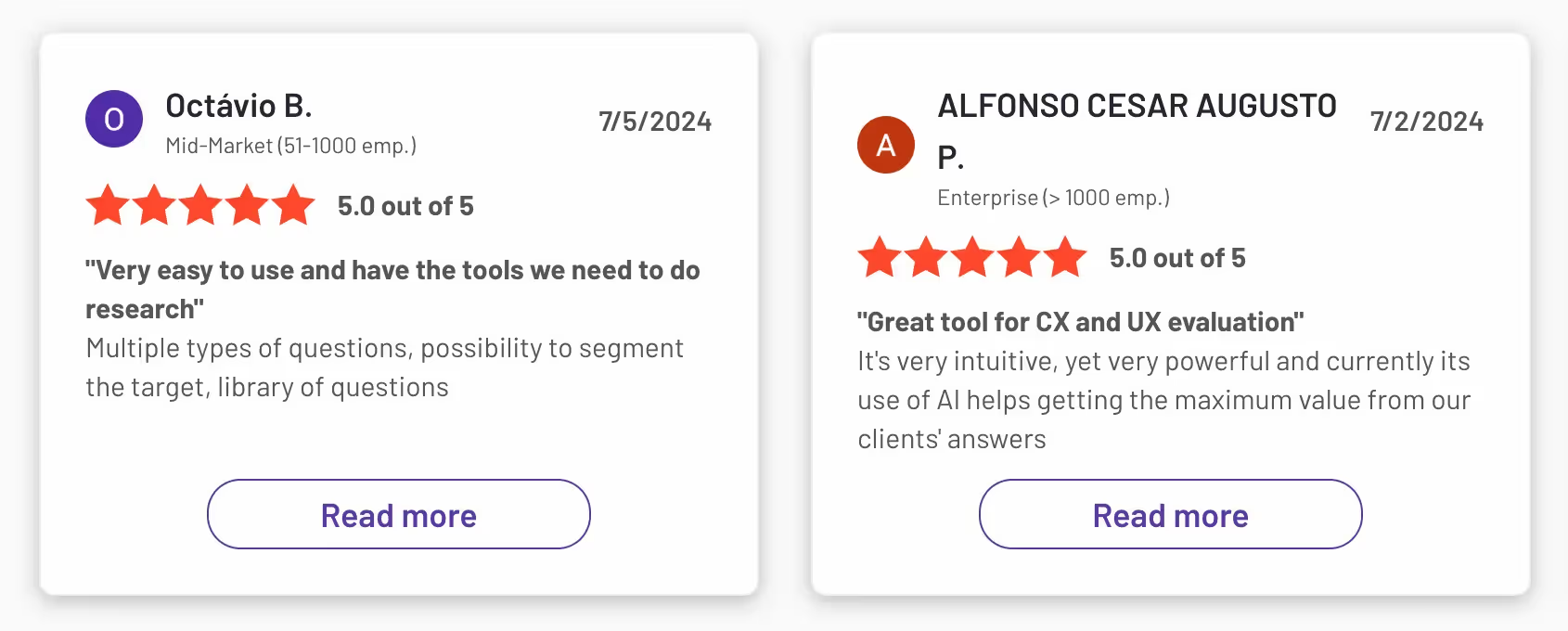
They help understand user satisfaction, identify friction points, and gather actionable insights, but they are also an opportunity to build rapport with your audience. Never neglect them, and always be sure to reply.
As you analyze feedback on your product pages, remember that visual presentation matters too, and improving your imagery with practical product photography tips can significantly influence how customers perceive quality and make purchase decisions.
Voice of Customer (VoC) analysis
You should collect Voice of Customer (VoC) feedback to understand user needs, preferences, and experiences. It is useful for gaining a comprehensive view of customer sentiments and identifying opportunities for improvement.
VoC analysis can be a helpful tool to inform product development and customer service strategies.
Importantly, you need consistency here, hence the systematic collection and analysis of feedback is essential.
Product analytics
Product analysis based on internal analytics is a fundamental element of any digital product. With the user behavioral analytics relevant to your product, you must be on top of the key metrics such as product adoption, user retention, churn, or lifetime value.
Remember, you should adjust the choice of metrics to your goals and needs. Too many of them will just create unnecessary noise. You should also establish one source of truth and democratize access to your tools.
User interviews
User interviews are, by far, the best method to obtain in-depth user insights. They allow the flexibility to ask the best research questions that, in turn, provide rich, detailed data. The downside? User interviews require a lot of resources, including time and money. The key to using them to the fullest is sound interview recruitment.
For example, Medscape runs product research surveys inside the product in which they recruit users for interviews.

We do it at Survicate, too. We also use Intercom conversations with customers to gather additional feedback and input on silent launches. Respondent attributes identify customers who would be good candidates for product testing.
Focus groups
Start with finding focus groups of people who already use a product similar to the one you are thinking of developing. You can enquire about things like an optimal price, the most important features, and the features that are missing in their current solution.
This can Additionally, you’ll learn about the qualities of your product that will make it unique and outbid your competitors.
To eliminate bias, choose third-party interviews or online surveys.
Concept testing
Concept testing is the process of surveying users about a potential product. You can learn how they feel about it and whether they would be willing to purchase it were it available on the market.
This method is very versatile, as it can be conducted online, over the phone, or through real-life interviews. It can be difficult to obtain a sample of potential clients willing to provide you with feedback, so we recommend using a customer feedback tool to facilitate the process.
A/B testing
With A/B testing, you compare two versions of a product or feature to determine which one performs better. It’s useful for optimizing design and functionality based on user preferences and behaviors.
A/B testing is often used during the product development phase to refine features and improve user experience.
Usability testing
After building an MVP, you need to show it to potential customers to get their feedback.
Usability testing involves observing users as they interact with a product to identify any usability issues. This method is useful for understanding how intuitive and user-friendly a product is. Usability testing is often conducted during the design and development stages to ensure the product meets user expectations and is easy to use.
This method is usually used in the later stages of product development to get the final product validation.
When to perform product research
Product research takes place throughout the whole development process. From the initial idea to post-launch, each stage requires its own set of research activities.
Before development
Discovery is probably the most important phase of product development when it comes to research. At this stage, you need to establish the fundamentals of the product. There are many questions you must answer to reduce risks before even thinking about the delivery phase:
🏮Who is it for?
🏮What problems will it solve?
🏮How is it different from the competition, and how does it position itself among similar products?
🏮Can you develop it?
🏮Will people buy it?
This is the time to research the market, define user personas, and get to know their problems, needs, and desires. When you find your niche and your target audience, you’ll have to decide how to position your product against the competition.
🔬Useful research methods: surveys, user interviews, product analytics, market research, product discovery, continuous product discovery
🔧Toolset: Check our list of popular product research tools.
Prototyping
Once you have validated your product idea, you’ll move on to prototyping initial versions to capture any usability and UX issues early on.
At this point, you’ll probably already be conducting research to see how your target audience perceives the early iterations of the product (or feature). Gathering product feedback at this stage will help you design a roadmap.
🔬Useful research methods: UX surveys, user interviews, product analytics, concept testing, focus groups, usability testing, A/B testing
🔧Toolset: Check our list of popular UX research tools.
Beta testing
After finding the sweet spot in accommodating user needs, functionality, usability, and your business goals, you’ll end up with a beta version of your product, something really ready to be tested in and out with a wider group of users.
This will help you understand how customers perceive your product or its new iterations, what they like and don’t like, and how you can still improve on it.
🔬Useful research methods: in-product and in-app surveys, user interviews, product analytics, focus groups, usability testing, A/B testing
Post-launch
So you’ve launched the product, but the research journey doesn’t end here—it is a continuous commitment. Make sure you collect relevant customer engagement metrics.
After launch, product research should focus on checking if the entire digital journey provides an engaging product experience. This is the time to evaluate if you have nailed your product’s positioning, product-market fit, and pricing.
🔬Useful research methods: user reviews, product analytics, user interviews, surveys: NPS, CSAT, CES, product-market-fit
🔧Toolset: Check our list of popular product feedback tools and conversion optimization tools.
How to conduct product research?
It’s time to look more closely at the very product research process. You already know it’s essential for developing a successful product. But where should you start? Let’s go through the best practices step by step.
Step 1: Define research objectives
Clearly outline what you aim to achieve with your research. This could include identifying market gaps, understanding user needs, validating product ideas, or improving an existing product.
Step 2: Identify your target audience
Knowing your audience is crucial. Define who’s your target while creating the product by understanding their demographics, needs, and behaviors.
Don’t forget to create detailed user persona profiles including their usage patterns, preferences, and decision-making processes.
It could look like this template ⤵️

You can collect this information upon signup, but you can also gather this data with a user persona survey distributing it, for example, directly in-product or via email.
Step 3: Choose research methods
Select the appropriate mix of quantitative and qualitative methods, and make use of existing data through secondary research.
📈Quantitative methods: surveys, data analysis, metrics
📝Qualitative methods: surveys, interviews, focus groups, user observations, online reviews
📚Secondary research: existing reports, competitor data, trend analysis
Step 4: Conduct the product research
Now it’s time to put it all into action and implement your chosen methods. Collect data accurately, ensuring objectivity throughout the process.

Step 5: Analyze data and draw insights
Analyzing the collected data to identify key patterns and trends is, traditionally, the most laborious part of the process. While drawing conclusions from quantitative data may be quite fast with the right tools and a wise metric choice, analyzing qualitative feedback is a different story.
To use your qualitative data to the fullest, use a customer feedback analytics tool, such as Insights Hub. It will dramatically cut down the time from raw feedback to contextual insights based on what your users are saying about the product in any feedback source you connect to this tool.
🔦Identify patterns and trends with quantitative data: Look for recurring themes and statistical trends.
Categorize qualitative feedback and draw actionable conclusions: Link findings directly to product improvements, prioritize changes based on user needs and develop product strategies to address identified challenges.
Step 6: Validate ideas with users
Test your ideas and solutions with existing customers and potential users. Remember to identify key user types before recruiting test participants.
⚖️Test ideas: Use interviews, focus groups, surveys, and usability tests to gather feedback.
🙊Account for bias: One way to combat confirmation bias and false-posititve responses is to alway focus on asking about a behavior in a certain context. As Teresa Torres puts it:
“Instead of asking, What criteria do you use when purchasing a pair of jeans?—a direct question that encourages our participant to speculate about their behavior—we want to ask, Tell me about the last time you purchased a pair of jeans.” [...] It will reflect their actual behavior, not their perceived behavior.
Step 7: Develop and test your MVP
Developing a Minimum Viable Product (MVP) is a result of creating multiple prototypes based on validated ideas and tests to improve subsequent iterations.
⚗️User tests: Use tree testing, card sorting, A/B tests, and heatmaps to confirm usability and functionality
🙌Quality assurance: Conduct QA testing, regression testing, and performance testing.
Step 8: Continue research post-launch
Even after the product launch, continue to gather data and user feedback to weed out bugs and refine the product.
- Gather data: Use user responses to adapt the product before a full rollout.
- Ongoing research: Stay connected with users and regularly analyze market trends and tech changes.
Run product research with Survicate
This guide has hopefully given you plenty of actionable advice on how to approach your product research projects. Now, if you’re ready to put those plans into action, Survicate gives you the tools to do it—faster and with more confidence.
Survicate is a customer feedback platform that helps product teams collect insights across the entire product lifecycle. You can run in-product or in-app surveys to capture feedback at exactly the right moment—like after launching a new feature, or while users interact with a prototype.
Want to recruit users for interviews or product testing? Use Survicate surveys to screen participants with qualifying questions, and show scheduling links only to those who match your criteria. You can also target specific user segments based on attributes or behavior—like power users, new signups, or trial customers.
With Insights Hub, you can bring all your feedback together—from surveys, online reviews, support chats, and sales calls—and have it automatically analyzed and grouped into key topics. Then use the AI Research Assistant to ask open-ended questions like “What are the most common feature requests from power users?” and get clear, instant answers.
Whether you're validating an idea, prioritizing features, or checking product-market fit, Survicate helps you do it with less guesswork and more clarity.
See how Survicate supports product research or sign up for a 10-day free trial to access all Growth plan features. You can explore everything Survicate has to offer for free or check out our flexible plans to find the one that fits your needs.










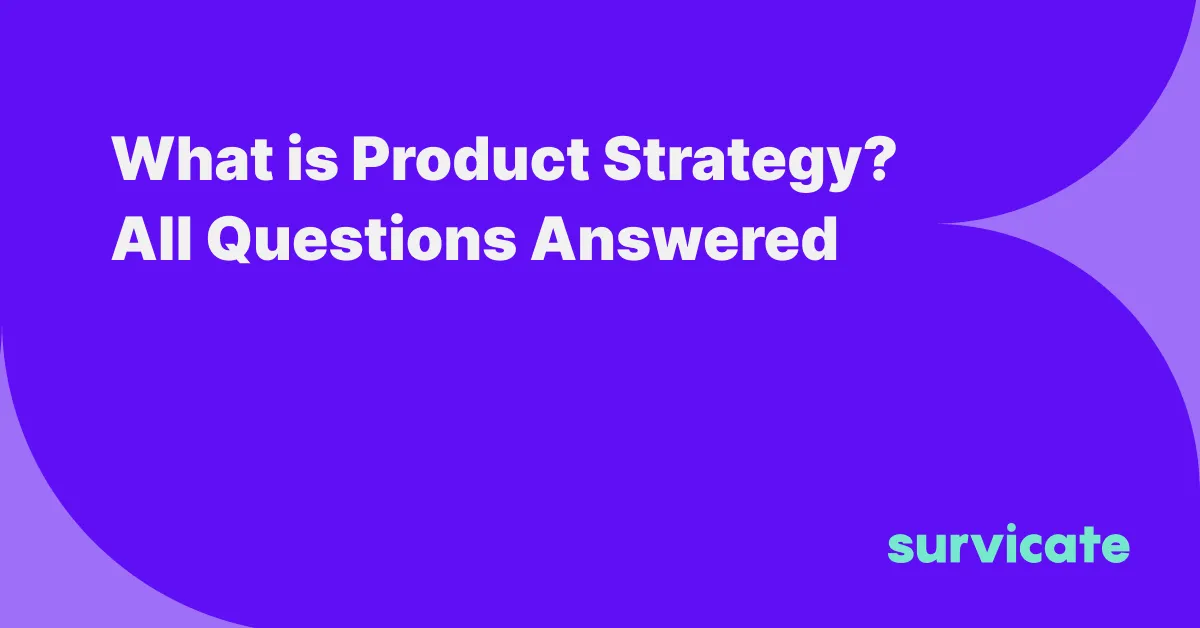
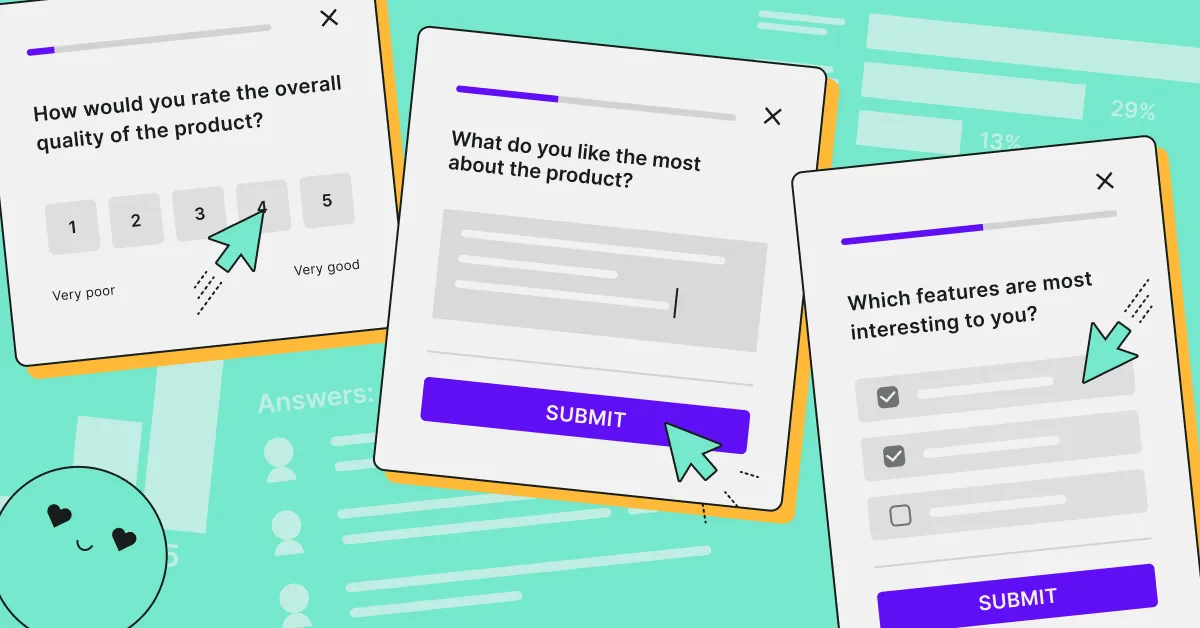
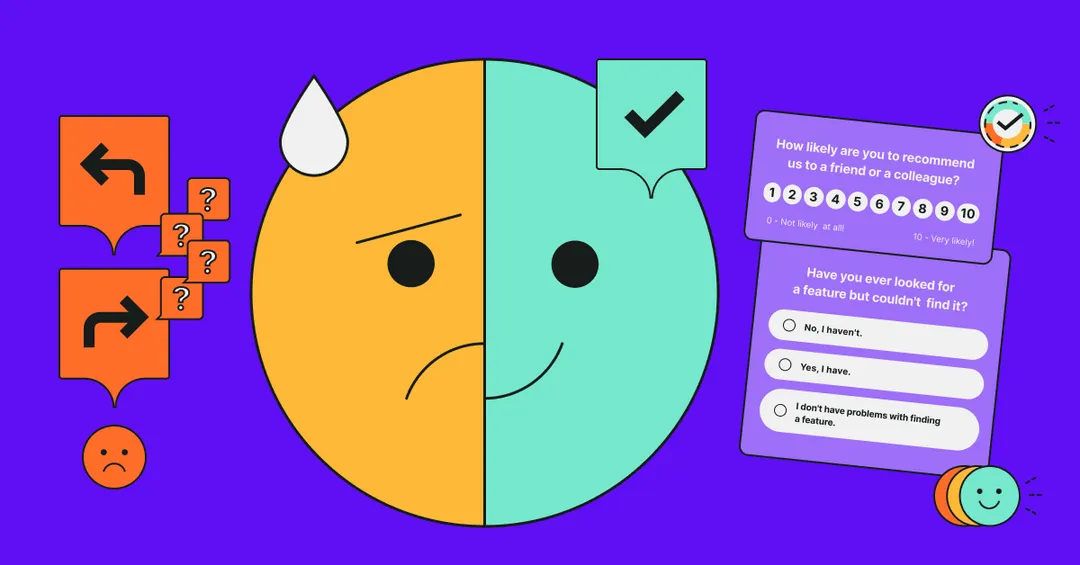
.webp)
.webp)
.svg)

.svg)



